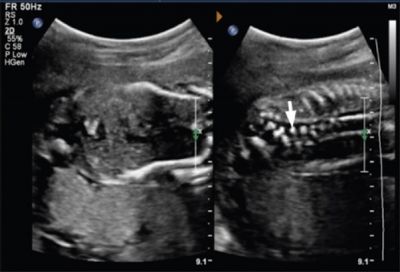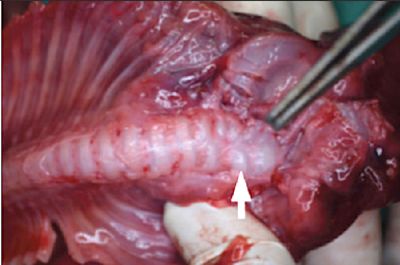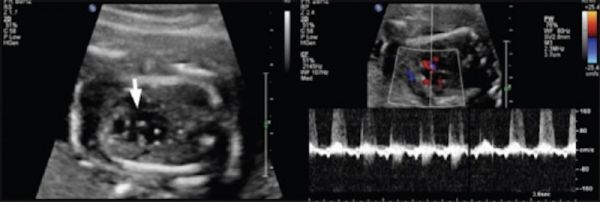VACTERL
| Embryology - 28 Apr 2024 |
|---|
| Google Translate - select your language from the list shown below (this will open a new external page) |
|
العربية | català | 中文 | 中國傳統的 | français | Deutsche | עִברִית | हिंदी | bahasa Indonesia | italiano | 日本語 | 한국어 | မြန်မာ | Pilipino | Polskie | português | ਪੰਜਾਬੀ ਦੇ | Română | русский | Español | Swahili | Svensk | ไทย | Türkçe | اردو | ייִדיש | Tiếng Việt These external translations are automated and may not be accurate. (More? About Translations) |
| ICD-11 - LD2F.11 VATER association - VACTERL/VATER is an association of congenital malformations typically characterized by the presence of at least three of the following: vertebral defects, anal atresia, cardiac defects, tracheo-esophageal fistula, renal anomalies, and limb abnormalities. |
Introduction
VACTERL/VATER are the acronyms used to describe a multi-system congenital malformation identified in the early 1970's and includes at least three of the following:
- Vertebral defects
- Anal atresia
- Cardiac defects
- Tracheo-esophageal fistula
- Renal anomalies
- Limb abnormalities
There is an additional identified form of VACTERL with hydrocephalus and perhaps several other associations exist.
VACTERL/VATER prevalence and incidence data have been difficult to ascertain due to variable diagnostic criteria. Some reports suggest less than 1-9/100,000 infants, and the annual incidence has been reported to be 1/10,000 to 1/40,000 live births.
Links: vertebra | heart | renal | gastrointestinal tract | limb
Some Recent Findings
|
| More recent papers |
|---|
|
This table allows an automated computer search of the external PubMed database using the listed "Search term" text link.
More? References | Discussion Page | Journal Searches | 2019 References | 2020 References |
| Older papers |
|---|
| These papers originally appeared in the Some Recent Findings table, but as that list grew in length have now been shuffled down to this collapsible table.
See also the Discussion Page for other references listed by year and References on this current page. |
VACTERL Diagnosis
| Feature | Intitial test(s) | Notes |
|---|---|---|
| Vertebral anomalies | X-ray; ultrasound and/or MRI of the spine | X-ray may not show subtle spinal anomalies, and will be unable to detect associated anomalies such as tethered cord or syrinx |
| Anal atresia | Physical examination/observation, abdominal ultrasound for genitourinary anomalies | Additional testing is typically required to define anatomy, especially if concomitant genitourinary anomalies are present |
| Cardiac malformations | Echocardiogram | Other, more precise techniques, such as cardiac CT or MRI may be helpful to further detail anomalies |
| Tracheo-esophageal fistula | Physical examination/observation (contrast studies are rarely required) | Patients with VACTERL association but without true TEF may still present with swallowing/breathing anomalies, and clinicians should have a low index of suspicion for confirmatory radiological testing |
| Renal anomalies | Renal ultrasound | Further testing, such as a voiding cystouerethrogram, may be required in the presence of renal anomalies or if there is other evidence of issues such as vesicoureteral reflux |
| Limb anomalies | Physical examination, X-ray | Important not to overlook, as the presence of limb anomalies often prompts testing for Fanconi anemia |
| Suggested testing for patients (in addition to a careful physical examination by an experienced clinician) suspected to have VACTERL association. Specific modalities used should be dictated by the risk-benefit ratio for the specific situation. | ||
| Table reference [5] Links: VACTERL | vertebra | heart | renal | limb | ||
Vertebral Defects
Hemi-vertebra noted in lumbo-sacral region of spine (arrow)[6]
| Ultrasound | Autopsy |
|---|---|

|

|
- Link: vertebra
Anal Atresia
Cardiac Defects
Endocardial cushion defect in form of absent crux. (arrow). (Right) Tricuspid regurgitation.[6]
Tracheo-Esophageal Fistula
Esophageal atresia[7] identified by the coiling of nasogastric tube (yellow arrow). Note also the limb anomaly of absent right radial ray bones (red arrow).
Renal Anomalies
Limb Abnormalities
References
- ↑ van de Putte R, van Rooij IALM, Marcelis CLM, Guo M, Brunner HG, Addor MC, Cavero-Carbonell C, Dias CM, Draper ES, Etxebarriarteun L, Gatt M, Haeusler M, Khoshnood B, Klungsoyr K, Kurinczuk JJ, Lanzoni M, Latos-Bielenska A, Luyt K, O'Mahony MT, Miller N, Mullaney C, Nelen V, Neville AJ, Perthus I, Pierini A, Randrianaivo H, Rankin J, Rissmann A, Rouget F, Schaub B, Tucker D, Wellesley D, Wiesel A, Zymak-Zakutnia N, Loane M, Barisic I, de Walle HEK, Roeleveld N & Bergman JEH. (2019). Spectrum of congenital anomalies among VACTERL cases: a EUROCAT population-based study. Pediatr. Res. , , . PMID: 31499513 DOI.
- ↑ Martín-Alguacil N & Avedillo L. (2019). VACTERL Association in a Female Pig (Sus scrofa domesticus). J. Comp. Pathol. , 173, 8-12. PMID: 31812176 DOI.
- ↑ Kause F, Zhang R, Ludwig M, Schmiedeke E, Rissmann A, Thiele H, Altmueller J, Herms S, Hilger AC, Hildebrandt F & Reutter H. (2019). HSPA6: A new autosomal recessive candidate gene for the VATER/VACTERL malformation spectrum. Birth Defects Res , , . PMID: 30887706 DOI.
- ↑ Jesse C, Jonathan S, Jeremy N & June K. (2019). A rare case of laryngeal cleft in association with VACTERL and malrotation. Radiol Case Rep , 14, 315-319. PMID: 30546815 DOI.
- ↑ Solomon BD. (2011). VACTERL/VATER Association. Orphanet J Rare Dis , 6, 56. PMID: 21846383 DOI.
- ↑ 6.0 6.1 Gaur NK & Gokhale S. (2018). VACTERL association - Ultrasound findings and autopsy correlation. Indian J Radiol Imaging , 28, 452-455. PMID: 30662209 DOI.
- ↑ Chauhan S et al. Int J Contemp Pediatr. 2017 Jul;4(4):1551-1553 http://www.ijpediatrics.com
Reviews
Lubinsky M. (2019). The VACTERL association: mosaic mitotic aneuploidy as a cause and a model. J. Assist. Reprod. Genet. , 36, 1549-1554. PMID: 31129863 DOI.
Solomon BD. (2018). The etiology of VACTERL association: Current knowledge and hypotheses. Am J Med Genet C Semin Med Genet , 178, 440-446. PMID: 30580478 DOI.
Lubinsky M. (2015). The VACTERL Association as a disturbance of cell fate determination. Am. J. Med. Genet. A , 167A, 2582-8. PMID: 26174174 DOI.
Solomon BD. (2011). VACTERL/VATER Association. Orphanet J Rare Dis , 6, 56. PMID: 21846383 DOI.
Articles
Yang L, Li S, Zhong L, Qiu L, Xie L & Chen L. (2019). VACTERL association complicated with multiple airway abnormalities: A case report. Medicine (Baltimore) , 98, e17413. PMID: 31626096 DOI.
Kassa AM, Engstrand Lilja H & Engvall G. (2019). From crisis to self-confidence and adaptation; Experiences of being a parent of a child with VACTERL association - A complex congenital malformation. PLoS ONE , 14, e0215751. PMID: 31002700 DOI.
Kang J, Mao M, Zhang Y, Ai FF & Zhu L. (2018). Congenital anal atresia with rectovestibular fistula, scoliosis, unilateral renal agenesis, and finger defect (VACTERL association) in a patient with partial bicornuate uterus and distal vaginal atresia: A case report. Medicine (Baltimore) , 97, e12822. PMID: 30407282 DOI.
External Links
External Links Notice - The dynamic nature of the internet may mean that some of these listed links may no longer function. If the link no longer works search the web with the link text or name. Links to any external commercial sites are provided for information purposes only and should never be considered an endorsement. UNSW Embryology is provided as an educational resource with no clinical information or commercial affiliation.
- Orphanet
- OMIM 192350 VATER/VACTERL ASSOCIATION
- OMIM 276950 VACTERL ASSOCIATION WITH HYDROCEPHALUS
- OMIM VACTERL ASSOCIATION, X-LINKED, WITH OR WITHOUT HYDROCEPHALUS; VACTERLX
- OMIM 140555 HEAT-SHOCK 70-KD PROTEIN 6; HSPA6
- OMIM 142989 HOMEOBOX D13; HOXD13
Glossary Links
- Glossary: A | B | C | D | E | F | G | H | I | J | K | L | M | N | O | P | Q | R | S | T | U | V | W | X | Y | Z | Numbers | Symbols | Term Link
Cite this page: Hill, M.A. (2024, April 28) Embryology VACTERL. Retrieved from https://embryology.med.unsw.edu.au/embryology/index.php/VACTERL
- © Dr Mark Hill 2024, UNSW Embryology ISBN: 978 0 7334 2609 4 - UNSW CRICOS Provider Code No. 00098G


